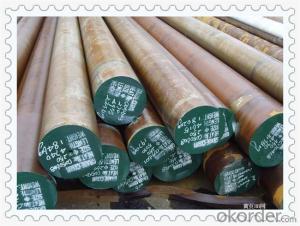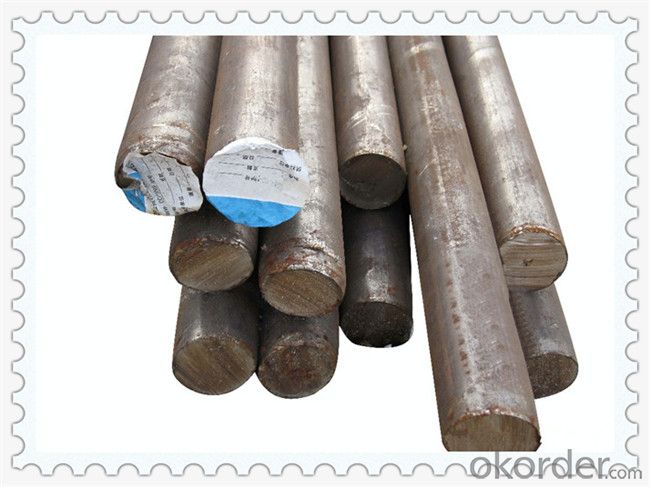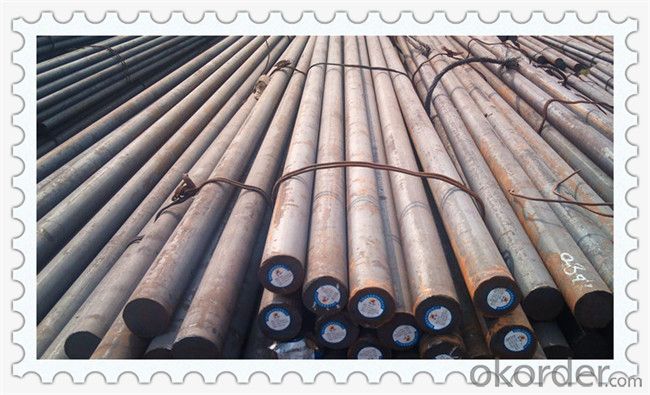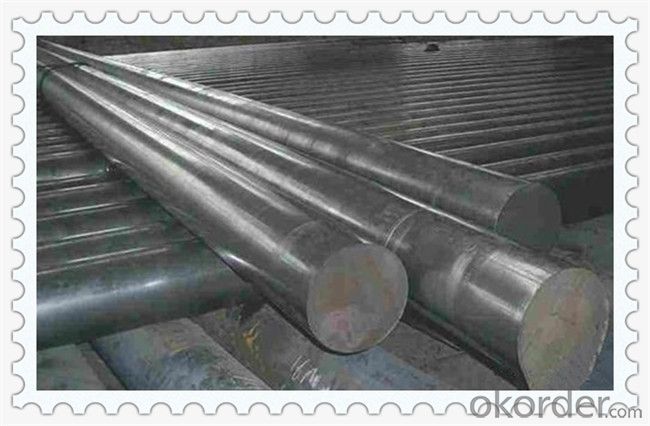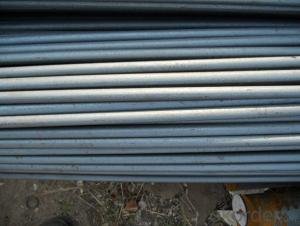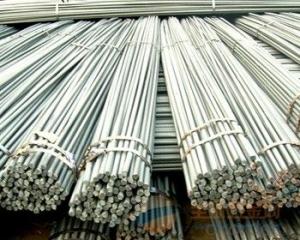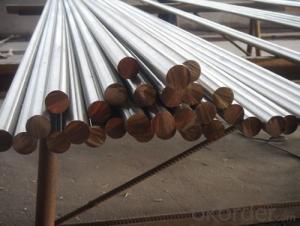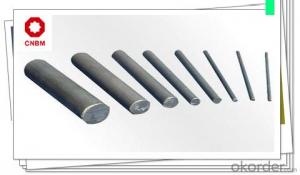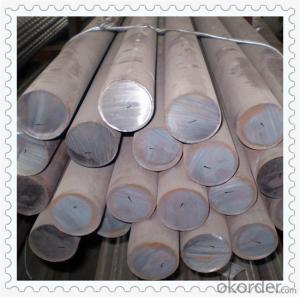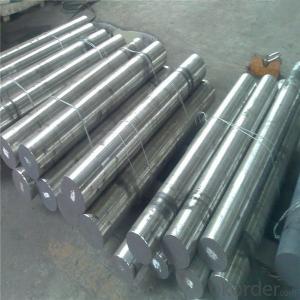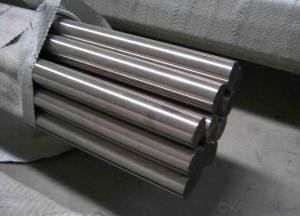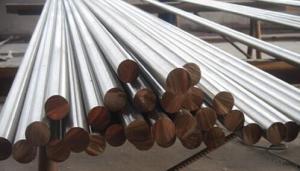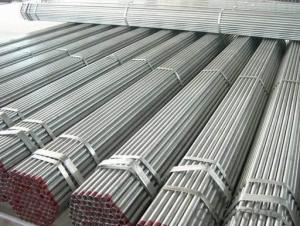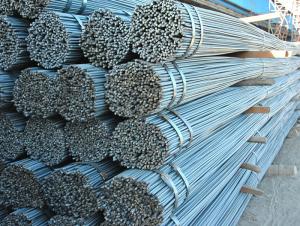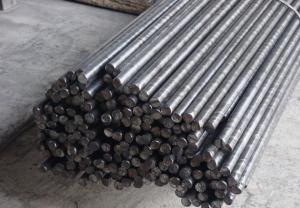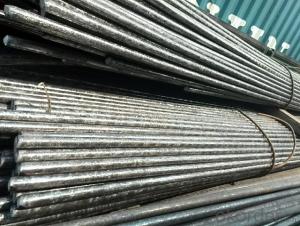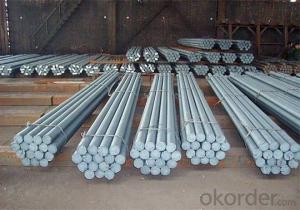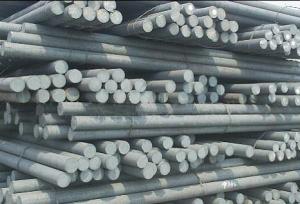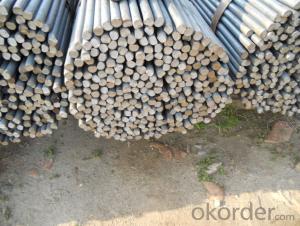35cd4 Alloy Structural Steel Round Bars
- Loading Port:
- China main port
- Payment Terms:
- TT OR LC
- Min Order Qty:
- 50 m.t.
- Supply Capability:
- 10000 m.t./month
OKorder Service Pledge
OKorder Financial Service
You Might Also Like
35cd4 Alloy Structural Steel Round Bars
Product Details
1. Sizes information
Diameter:10-310mm
Length:canbe required to any sizes. (Commenly from 4m-6m)
Length tolerange:+/-100mm(max)
Straightness:3mm/m(max)
2. Advantage of 35crmo steel
35CrMo alloy steel, a high static strength, impact toughness and high fatigue limit.
35CrMo has better Hardenability than 40Cr,and has high strength and high creep rupture strength under high temperature, long-term working temperature up to 500 °C
3. Mechanical Properties
| Grade | Tensile Strength (Mpa) | Yield Strength (Mpa) | Elongation (%) | Reduction of Area (%) | Charpy Impact (J) | Hardness (HB) |
| 35cd4 | ≥985 | ≥835 | ≥12 | ≥45 | ≥63 | 229 |
4. Chemical composition
| Grade | C | Cr | Mo | Si | Mn | P | S | Ni | Cu |
| 35cd4 | 0.32-0.40 | 0.80-1.10 | 0.15-0.25 | 0.17-0.37 | 0.40-0.70 | ≤0.035 | ≤0.035 | ≤0.30 | ≤0.30 |
5. Other Grades
Carbon Steel Round Bar | SS400, S235JR,Q235, ASTM A36, Fe360A, Fe360B,SM400A,080A15, SS41,E235B |
SAE 1020, AISI 1020, ASTM 1020, S20C, 20#, 050A20 | |
SAE 1045, AISI 1045, ASTM 1045, S45C, 45#,EN8, XC45, XC48, 45B, C45, CK45, CM45, 060A47, R683/IC45e | |
Alloy Steel Round Bar | 40Cr, DIN 1.7035, SAE 5140, AISI 5140, ASTM 5140, SCr440, 41Cr4, 530A40, 42Cr4, 40X, R683/VII3 |
SAE4140,42CrMo, 42CrMo4, DIN 1.7225, SCM440,EN19, 42CD4, 708M40, R683/II3 | |
SAE 4340, 40CrNiMoA, EN24, SNCM439, 817M40,40XMA, R683/III4 | |
SAE 8620,,AISI 8620, ASTM 8620, 20CrNiMo,SNCM220, 805M20 | |
SAE52100, AISI52100,ASTM E52100, GCr15, SUJ2, 100C6, 100Cr6, 1.3505, 534A99, IIIX15 |
Products Show
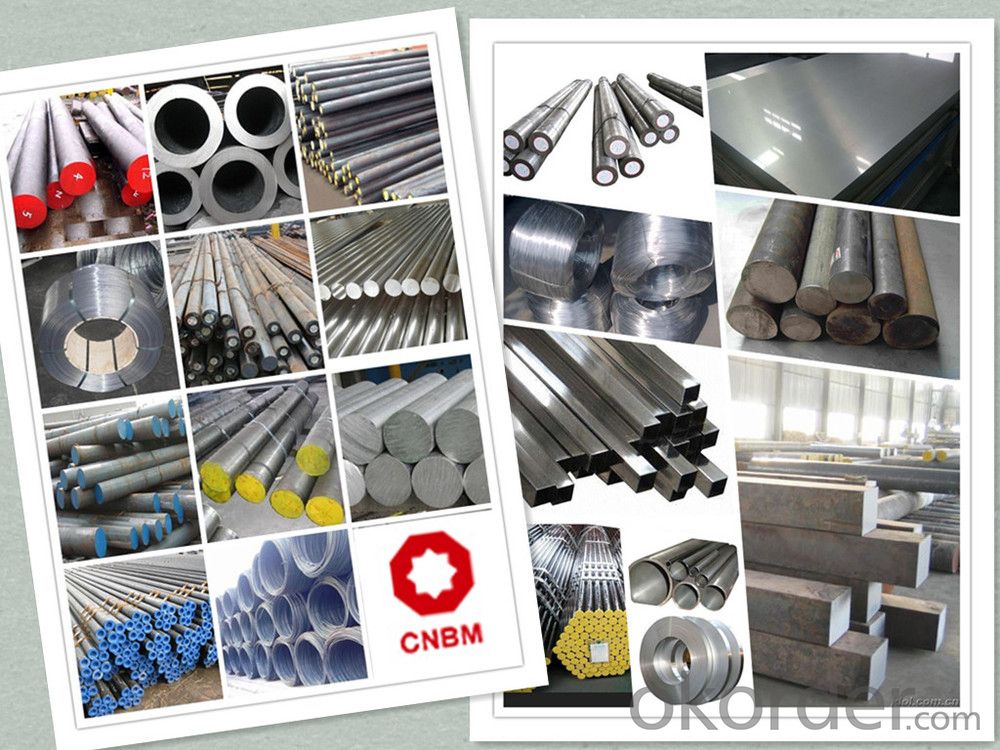
Product Overviews
| Product Name | Typical Grades | Diameter(mm) | Standard adopted |
| Carbon Steel | 20 (1020/S20C/C22) | Ø16-Ø300 |
GB/SAE/JIS/DIN
|
| 40 (1040/S40C/C40) | |||
| 45 (1045/S45C/C45) | |||
| Bearing Steel | GCr9 (51100/SUJ1) | Ø12-Ø250 | |
| GCr15 (52100/SUJ2/100Gr6) | |||
| GCr9SiMn (A485-Gr.1/SUJ3) | |||
Cr-Mo Steel | 20Cr (5120/SCr420H/20Cr4) | Ø12-Ø250 | |
| 40Cr (5140/SCr440/41Cr4) | |||
| 42CrMo(4140/SCM440/42CrMo4) | |||
| Gear Steel | 20CrNiMo | Ø16-Ø600 | |
| 20CrMn(5115/SMnC420/20MnCr5) | |||
| 20CrNiMo(8620/SNCM220/20CrMiMo2) |
Application
| Carbon Steel | Mold bottom, Plastic mold, Construction machinery parts Automobile parts, Security grills, Screens, Construction |
| Bearing Steel | Aerospace, Navigation, Nuclear energy, Chemical industry Electronic information, Petrochemical, Instrument and meter Transportation |
| Cr-Mo Steel | Mechanism & Fasteners gear, Stressed components for vehicles Engines and machines, Parts of larger cross-section |
| Gear Steel | All kinds of gears, Statically and dynamically stressed component for vehicles Engines and machine, Larger cross-section parts, Crankshafts |
Work Shop
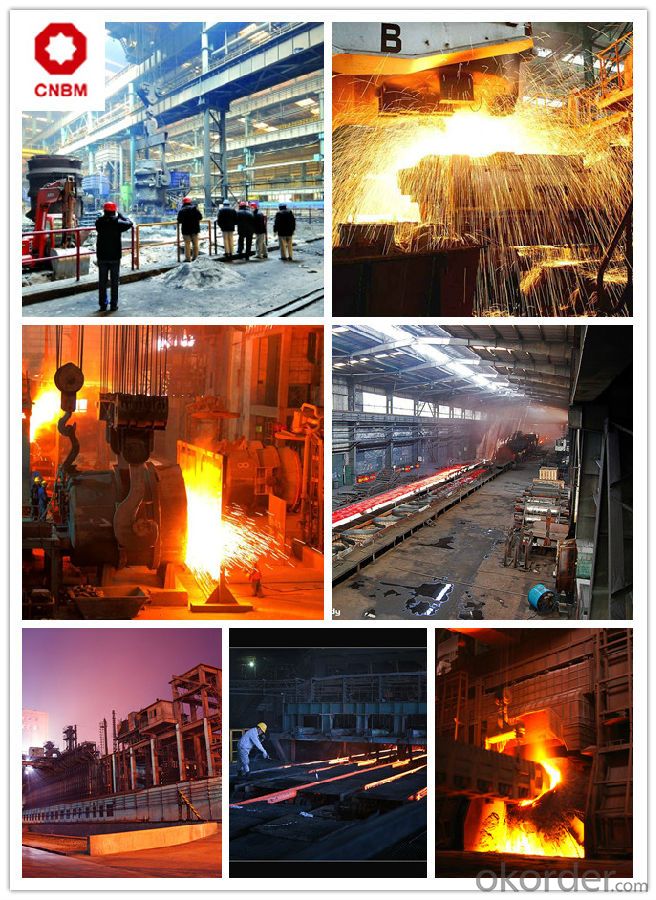
Company Information
CNBM International Corporation is the most important trading platform of CNBM group.
Whith its advantages, CNBM International are mainly concentrate on Cement, Glass, Iron and Steel, Ceramics industries and devotes herself for supplying high qulity series of refractories as well as technical consultancies and logistics solutions.

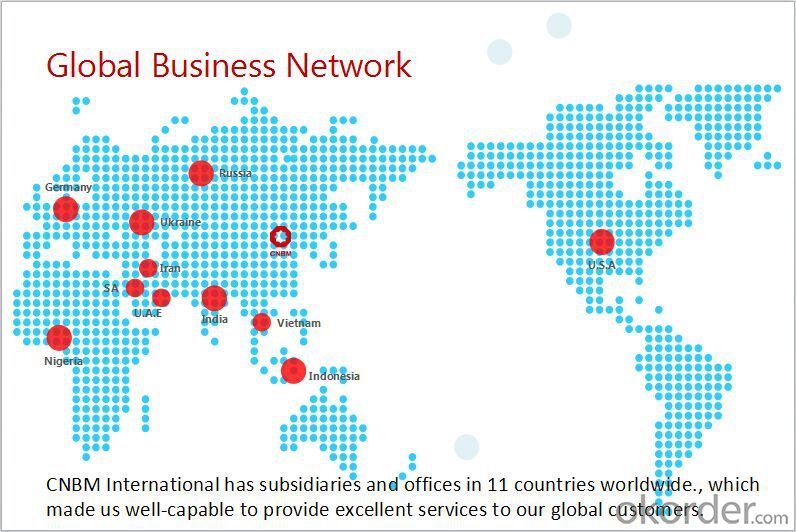
FAQ
1, Your advantages?
professional products inquiry, products knowledge train (for agents), smooth goods delivery, excellent customer solution proposale
2, Test & Certificate?
SGS test is available, customer inspection before shipping is welcome, third party inspection is no problem
3, Factory or Trading Company?
CNBM is a trading company but we have so many protocol factories and CNBM works as a trading department of these factories. Also CNBM is the holding company of many factories.
4, Payment Terms?
30% TT as deposit and 70% before delivery.
Irrevocable L/C at sight.
5, Trading Terms?
EXW, FOB, CIF, FFR, CNF
6, After-sale Service?
CNBM provides the services and support you need for every step of our cooperation. We're the business partner you can trust.
For any problem, please kindly contact us at any your convenient time.
We'll reply you in our first priority within 24 hours.
Packaging & Delivery
1, Packaging: seaworthy package or as required
2, Delivery: 35-45 days or based on quantity
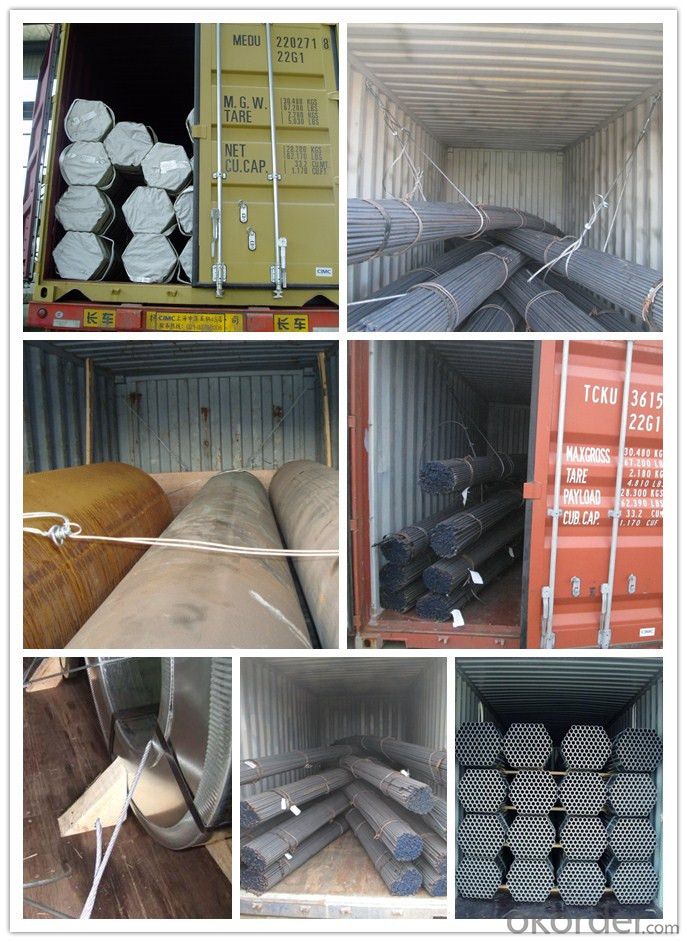
- Q: Can steel round bars be bent or formed?
- Yes, steel round bars can be bent or formed. They have the ability to be shaped into various angles or curves through the application of force, typically using tools such as a hydraulic press or bending machine.
- Q: What are the different types of finishes available for steel round bars?
- Steel round bars offer a variety of finishes, each with its own unique properties and appearance. 1. Mill Finish: The most commonly used finish is the mill finish, where the steel is left in its natural state after rolling and cooling. This results in a rough texture and the possibility of surface imperfections. 2. Hot Rolled Finish: Achieved by heating the steel to high temperatures and shaping it through rolling. This finish provides a smooth surface and is typically used in applications where aesthetics are not a priority. 3. Cold Drawn Finish: Involves pulling the steel through a die to reduce its diameter and increase its length. This finish offers a smooth surface, improved dimensional accuracy, and tighter tolerances. 4. Polished Finish: Steel round bars can be polished to achieve a smooth and reflective surface. This is done using abrasive materials or compounds to remove imperfections and enhance appearance. 5. Ground Finish: A process that involves removing a thin layer of material from the steel surface using abrasive grinding wheels. This creates a smooth and even finish suitable for applications that require precise dimensions and tight tolerances. 6. Coated Finish: Steel round bars can be coated with different materials for added protection against corrosion or to enhance appearance. Common coatings include galvanization, which applies a layer of zinc, and powder coating, which provides durability and a decorative finish. When choosing a finish for a steel round bar, it is important to consider the specific application and desired properties. Factors such as corrosion resistance, aesthetics, dimensional accuracy, and surface quality should be taken into account.
- Q: What are the advantages of using nickel-chromium-titanium alloy steel round bars?
- There are several advantages of using nickel-chromium-titanium alloy steel round bars: 1. High Strength: Nickel-chromium-titanium alloy steel round bars are known for their exceptional strength and durability. They have a high tensile strength, making them suitable for applications requiring heavy-duty materials. 2. Corrosion Resistance: These alloy steel round bars have excellent corrosion resistance properties due to the presence of nickel and chromium. This makes them ideal for use in environments where exposure to moisture, chemicals, or harsh conditions is common. 3. Heat Resistance: Nickel-chromium-titanium alloy steel round bars can withstand high temperatures without losing their mechanical properties. They exhibit good heat resistance, making them suitable for applications in industries such as aerospace, power generation, and automotive. 4. Fatigue Resistance: The unique composition of nickel-chromium-titanium alloy steel round bars provides excellent fatigue resistance, allowing them to withstand repeated stress and load cycles without deformation or failure. This makes them suitable for applications in high-stress environments. 5. Machinability: Despite their high strength and toughness, nickel-chromium-titanium alloy steel round bars are relatively easy to machine. They can be easily cut, drilled, or shaped, allowing for efficient and precise manufacturing processes. 6. Versatility: These alloy steel round bars have a wide range of applications due to their versatile properties. They can be used in industries such as construction, automotive, aerospace, marine, and many more. Their high strength and corrosion resistance make them suitable for various structural and load-bearing applications. Overall, nickel-chromium-titanium alloy steel round bars offer a combination of high strength, corrosion resistance, heat resistance, fatigue resistance, machinability, and versatility, making them a preferred choice for many industrial applications.
- Q: What are the advantages of using boron-alloy steel round bars?
- Using boron-alloy steel round bars in various applications offers several advantages. Firstly, compared to traditional carbon steel, boron-alloy steel has significantly higher strength. This increased strength enables the construction of lightweight and durable structures, reducing material costs and improving overall efficiency. Additionally, boron-alloy steel round bars exhibit excellent hardenability. This means they can be heat-treated to achieve desired properties such as increased hardness and wear resistance. This makes them ideal for demanding applications in industries like automotive and construction, where high strength and durability are necessary. Another advantage of boron-alloy steel round bars is their enhanced weldability. They can be easily welded without sacrificing their mechanical properties, allowing for seamless integration into various fabrication processes. This saves time and effort during assembly and ensures the structural integrity of the final product. Furthermore, boron-alloy steel round bars offer excellent resistance to abrasion and corrosion. This makes them suitable for use in harsh environments or applications where exposure to chemicals or moisture is common. The extended lifespan of the material reduces the need for frequent repairs or replacements, resulting in cost savings and improved productivity. Lastly, boron-alloy steel round bars are readily available and cost-effective compared to other high-strength steel alternatives. Their wide availability makes them a viable option for a range of applications, from manufacturing machinery to constructing infrastructure. In summary, the benefits of using boron-alloy steel round bars include higher strength and durability, improved hardenability, enhanced weldability, resistance to abrasion and corrosion, and cost-effectiveness. These advantages make them an excellent choice for various industries that require lightweight, strong, and long-lasting materials.
- Q: What are the disadvantages of using steel round bars?
- There are a few disadvantages associated with using steel round bars. Firstly, steel round bars can be quite heavy, making them difficult to handle and transport. Secondly, steel round bars can corrode if not properly protected, which can lead to structural weakness and reduced lifespan. Additionally, steel round bars may not be suitable for certain applications that require lightweight or non-magnetic materials. Lastly, steel round bars can be more expensive compared to other materials, which may impact the overall project cost.
- Q: What are the typical dimensions of a steel round bar?
- The dimensions of a steel round bar can vary depending on the specific application and industry requirements. Generally, diameter sizes for steel round bars range from 1/4 inch to 24 inches. These sizes are often measured in increments of 1/8 inch or 1/4 inch. The length of a steel round bar is usually standardized at 20 feet, although shorter lengths may also be available. It is important to consider that these dimensions can significantly differ based on the grade and type of steel used, as well as the manufacturing process. Therefore, it is crucial to refer to the appropriate industry standards or consult a supplier for precise dimensions required for a particular project.
- Q: How do you calculate the weight of a steel round bar?
- To calculate the weight of a steel round bar, you need to know its diameter and length. The weight can be calculated using the formula: weight = (diameter^2) × length × 0.006165, where the diameter is in inches and the length is in feet.
- Q: Can steel round bars be used in the production of springs?
- Yes, steel round bars can be used in the production of springs. Steel round bars are commonly used as raw materials for manufacturing various types of springs due to their strength, durability, and high tensile properties. They can be machined or cold-formed into the desired shape, providing the necessary flexibility and resilience required for spring applications.
- Q: How do you prevent steel round bars from warping during machining?
- To prevent steel round bars from warping during machining, there are several measures that can be taken: 1. Proper material selection: Choose steel round bars with low residual stress and uniform internal structure. This can minimize the chances of warping during machining. 2. Pre-machining stress relief: Subject the steel round bars to stress-relieving heat treatment before machining. This process helps to release any internal stress and stabilize the material, reducing the likelihood of warping. 3. Adequate machine setup: Ensure that the machine used for machining the steel round bars is properly calibrated and aligned. Any misalignment or imbalance can induce stress and cause warping. Regular maintenance and inspection of the machine's components are essential. 4. Proper cooling techniques: During the machining process, use appropriate cooling methods to control the temperature. Excessive heat buildup can lead to thermal distortion and warping. Lubricants and coolants can be employed to dissipate heat effectively and maintain stable machining conditions. 5. Using the right cutting tools: Employ high-quality cutting tools that are specifically designed for machining steel. Dull or incorrect tools can generate excessive heat and cause warping. Regular tool inspection and replacement are necessary to ensure optimal performance. 6. Appropriate cutting parameters: Adjust the cutting parameters such as cutting speed, feed rate, and depth of cut to suitable levels for the specific steel grade and machining operation. Improper cutting parameters can generate excessive heat and contribute to warping. 7. Minimize interrupted cuts: Avoid interrupted cuts whenever possible, as they can induce stress concentrations and increase the likelihood of warping. If interrupted cuts are necessary, use proper tool entry and exit strategies to minimize stress points. 8. Post-machining stress relief: After machining, subject the steel round bars to stress-relieving heat treatment again to relieve any residual stresses induced during the machining process. This step can help to further minimize warping. By following these preventive measures, the risk of steel round bars warping during machining can be significantly reduced, ensuring high-quality and accurate machined components.
- Q: What is the difference between a hot-rolled and a cold-drawn steel round bar?
- The main difference between a hot-rolled and a cold-drawn steel round bar lies in the manufacturing process. Hot-rolled steel round bars are formed by heating and rolling the steel at high temperatures, resulting in a rougher surface finish and less precise dimensions. On the other hand, cold-drawn steel round bars are formed by pulling the steel through a die at room temperature, resulting in a smoother surface finish and more precise dimensions. Cold-drawn steel round bars also tend to have improved mechanical properties and a higher strength-to-weight ratio compared to hot-rolled steel round bars.
Send your message to us
35cd4 Alloy Structural Steel Round Bars
- Loading Port:
- China main port
- Payment Terms:
- TT OR LC
- Min Order Qty:
- 50 m.t.
- Supply Capability:
- 10000 m.t./month
OKorder Service Pledge
OKorder Financial Service
Similar products
Hot products
Hot Searches
Related keywords
